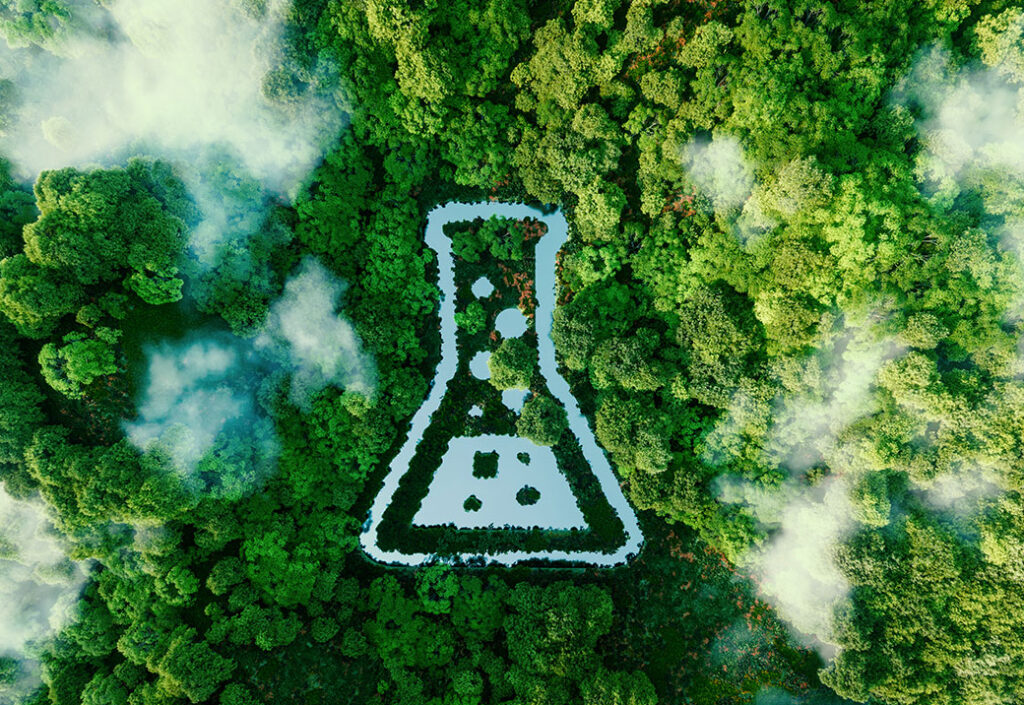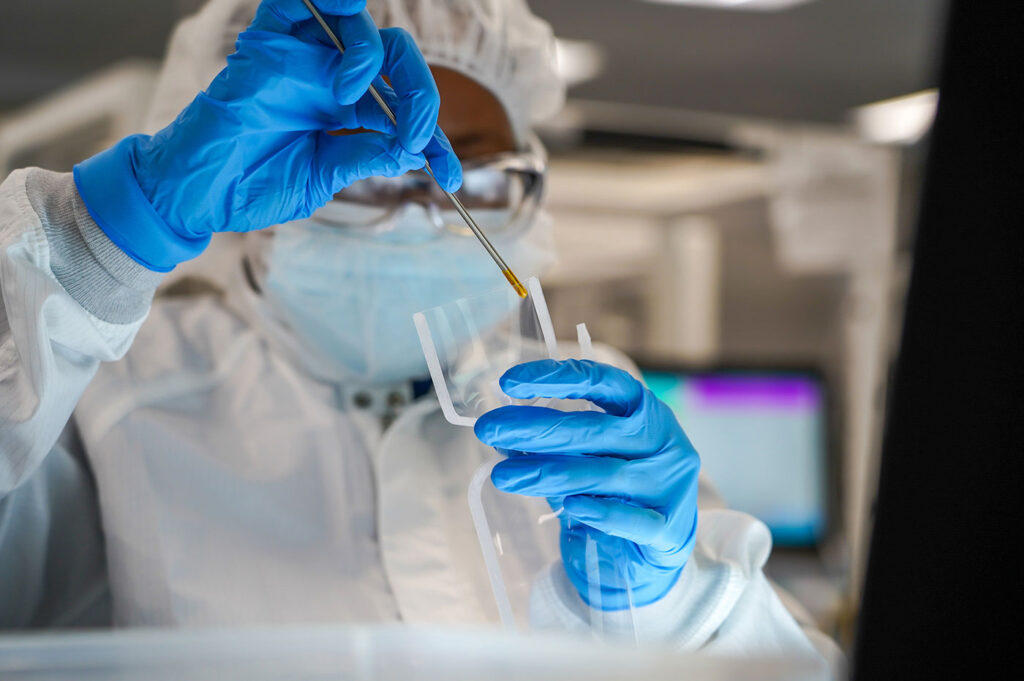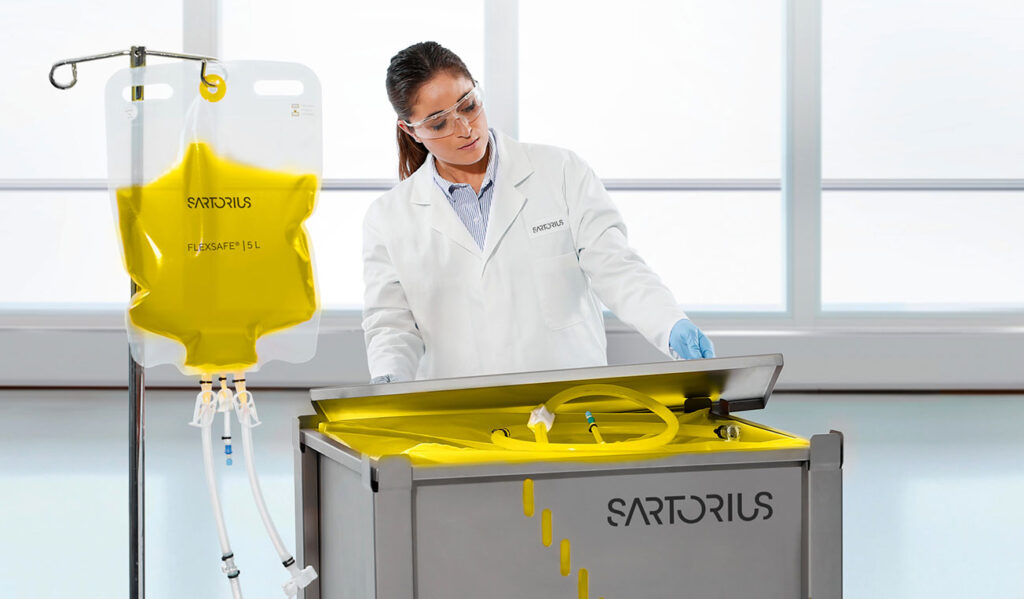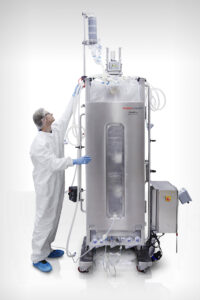The biomanufacturing industry is determined to not only save patients’ lives but also the environment. This commitment makes long-term environmental sustainability an increasingly central concern for industry stakeholders. Sick patients will always need therapies, but the compositions and manufacturing of those therapies can change as new discoveries are turned into viable treatments, such as the growing use of biologic modalities. These changes are forcing the entire healthcare landscape, including manufacturers, to continue to adapt.
Transitioning manufacturing processes can be fraught with challenges. The industry continues to grapple with the large footprints of legacy biomanufacturing facilities that consume massive amounts of water, electricity, and natural gas. Newer therapeutic modalities are manufactured in smaller batches often in closed process systems, decreasing the need for traditional large cleanrooms and stainless-steel bioreactors. However, these emerging systems impose a different environmental impact due to their reliance on single-use consumables.
Still, progress is being made. The biomanufacturing industry aims to achieve net-zero emissions by 2050. Renewable energy sources are playing a larger role for electrical needs as these power sources become more available globally. And the efforts do not stop there. Products are being developed or redesigned with smaller carbon and water-usage footprints. Adoptable scenarios for the recycling of single-use products are under evaluation as well as ways to cut down the amount of transport needed to get the products to the end users.
At Merck & Co., the green and sustainable science team for biologics aims to design bioprocesses with a smaller carbon footprint, reduced water and energy use, and greater recycling of raw materials. Additionally, the tea is tasked with establishing appropriate metrics and criteria that will aid in evaluating and promoting practices that can make a positive impact on the sustainability of bioprocesses.
“We have clearly defined internal sustainability targets that inform and benchmark the biologics commercial processes developed for new assets in our pipeline,” said Sri Madabhushi, PhD, principal scientist, Merck Research Laboratories.
Published works and industry presentations demonstrate the team’s dedication. One example is a strategy for reprocessing and reusing permeate from perfusion cultures for monoclonal antibody production. Others include the application of process mass intensity—comparing the mass of materials used against the mass of the final product—to compare continuous and batch manufacturing processes for biologics and inform life cycle assessments of single-use technology.
Madabhushi pointed out that a major hurdle is the limited availability of information and lack of understanding of sustainability impact across every stage, including raw materials, supply chains, processes, facilities, transportation, and end-of-life cycle of products and consumables. Collaboration is required between vendors, suppliers, facilities, and manufacturers to address this challenge.
Energy utilization
Energy utilization to run the equipment, cleanroom requirements, and HVAC systems for biologics manufacturing plants is a primary contributor to overall sustainability of biologics manufacturing processes. Using process intensification to optimize space, time, and yield in manufacturing plants, along with the use of comprehensive metrics that consider these factors, will be more indicative of the key factors driving sustainability.

“To create a meaningful impact, it is crucial to foster a ‘sustainability mindset’ alongside the scientific components of the discipline,” Madabhushi stressed. “Merck uses the power of leading-edge science to save and improve lives around the world. Operating responsibly is at the heart of our ability to deliver sustainable impact—driving long-term value for our company and society.”

Saint-Gobain Life Sciences provides single-use components and assemblies for the biopharmaceutical market. In addition to decarbonization, reducing nonvalorized manufacturing waste (which cannot be repurposed, recycled, or reused) and more efficient use of manufactured raw materials are high priorities.
Biomanufacturing’s energy consumption, especially in cleanroom operations, contributes significantly to its carbon footprint. Natural gas is also widely used for HVAC systems, heating processes for producing purified water, and for steam-in-place cleaning of stainless-steel infrastructure. Membrane-based water filtration systems and electric heat pumps could help gradually reduce natural gas usage but have their own challenges. Decarbonization of the electricity grid with mostly renewable sources, coupled with capital investments to electrify heat, would have the most significant sustainability effect.
Another alternative to reduce natural gas usage is replacing stainless-steel reactors and piping with single-use plastics that eliminate the need for sterilization-in-place cleaning. Single-use technologies, especially coupled with continuous processes, enable process intensification, reducing energy requirements and facility and carbon footprints. However, these technologies generate more plastic waste.
Less plastic waste, more recycling
This complex and interconnected plastic waste consists of tubes, bags, and filters made from multiple materials that are not easy to recycle or transform. Yeshwanth Narendar, PhD, head of R&D and Innovation, Saint-Gobain Life Sciences, pointed out that the single-use supplier ecosystem is developing strategies to minimize plastic waste as well as recycling approaches. “Our goals,” he said, “are to introduce low-carbon products containing recycled content or bio-based materials and to develop products that improve biomanufacturing efficiency.”
One notable product is a novel cell culture chamber, the VueLife HP bag. It can produce upwards of 7B viable T cells in 10 days. According to Narendar, the high cell growth numbers and performance reliability reduce the number of bags required to achieve clinically relevant T-cell doses per patient.
In addition, ValPlus tubing carries certifications for subvisible particulates, endotoxins, and bioburden. Precertified cleanliness can eliminate the need for tubing rinsing with Water for Injection. Existing products are also being rethought, such as the substitution of a lower carbon alternative for a carbon-intensive fluoropolymer in a fluid flow clamp.
Carbon footprinting is a first step toward evaluating the sustainability performance of products and processes. However, as Merck & Co.’s Sri Madabhushi indicated previously, these data are often limited and can inaccurately rely on spend-based approximations. Narendar believes a centralized product carbon footprint framework would align carbon footprint accounting and data sharing, such as the one BioPhorum is currently developing that builds on work previously accomplished by Together for Sustainability for the chemical sector.
Sartorius Stedim Biotech says it believes in sustainability by example. Many key technologies undergo life cycle analysis. “We also use eco-design principles while developing new technologies or reviewing existing technologies,” explained Miriam Monge, head of Marketing FMT, Sartorius.

For example, the Maxicap MR next generation of single-use large-scale Maxicap filters has been reassessed with an eco-design that offers the same quality with more efficient use of materials, reduced plastic use, and low volume packaging, Monge noted.
Bioprocess modeling of single-use technologies provides insight into the environmental impact when compared to stainless-steel as well as to fed-batch vs. process intensification. Monge pointed out that implementing single-use technologies in an intensified process opens an opportunity for large energy, water, and electricity savings.
“The biggest challenge with single-use systems is waste management. The industry must develop an overall approach that end users can implement and that recyclers can integrate into a viable business model,” Monge emphasized. Collaborative work is ongoing, notably through BPOG (BioPhorum Operations Group) and BPSA (Bio-Process Systems Alliance) sustainability working groups.
To perform a proof-of-concept study of mechanical recycling of the Flexsafe film used in the manufacture of single-use bag technologies Sartorius collaborated with Sanofi and recycler Veolia. The effort highlighted the importance of collaboration.
Results showed that recycled Flexsafe bag chambers, made from as pure-as-possible LDPE film, can technically be used for films, bags, pipes and fittings, profiles, and flexible sheets if an appropriate sorting and massification solution is identified. The trade-off between the quality and quantity of the recycled plastic will be further evaluated along with the cost and efficiency of sorting (results can differ highly for multilayer films utilizing various plastics).
Sartorius uses comprehensive process validation and in-process controls to reduce scrap generation during the single-use manufacturing process. In addition, bag chamber production and final assembly are managed regionally to reduce local transport requirements.
Another venture focused on sustainability is va-Q-tec. It designs and implements shipping solutions for frozen bulk drug substances. A joint platform combining the Celsius FFT bulk shipper with the va-Q-tainer pay-per-use rental service results in cost-effective and simplified coordination.
Each biomanufacturer develops specific process designs, even for mature platforms. “If the industry could accept higher levels of standardization in technology designs and overall platform approaches, it would allow us to envisage new business models in terms of economics of manufacturing, logistics, shipping, etc. that could potentially have a significant impact on overall environmental sustainability,” Monge said.
Greener by design
Merete Miles, senior director, Environmental Sustainability, Thermo Fisher Scientific, leads the global environmental sustainability strategy for the life sciences businesses, which ladders up to the company-wide corporate social responsibility goals. The sustainability program involves reducing emissions, waste, and water usage; designing products with sustainability in mind; and collaborating with partners to accelerate the efforts.
Thermo Fisher is interested in doing more than achieving net-zero emissions. It is also intent on dramatically reducing water usage. Biomanufacturing processes such as upstream cell culture and downstream purification are, by their nature, highly water intensive. Thermo Fisher’s DynaDrive Single Use Bioreactor reduces water usage as well as waste generation in these processes. The company is also addressing water use at their own sites. “Our water-intensive facilities in areas with scarce water supplies will be assessed next year to identify additional water reduction opportunities,” Miles said.”
One-hundred percent renewable electricity currently powers 150 sites due to virtual power purchase agreements signed in China, India, and South Africa. The same strategy is planned for all current U.S. sites. “We also recently announced an additional 2030 target to achieve 80% renewable electricity globally in alignment with the Sustainable Markets Initiative (SMI) Health Systems Task Force joint supplier standards,” Miles added. “To provide transparency, we work with accountability partners such as CDP and EcoVadis to ensure the success of our programs.”

Zero waste is an essential component of the plan, hence the “greener by design” and third party Zero Waste certification programs. Products designed with an environmental sustainability focus include Thermo Fisher’s DynaDrive Single-Use Bioreactor, which was developed to help customers efficiently scale their protein and monoclonal antibody workflows. Single-use technology offers flexibility, scale, speed, and cost advantages and removes the need for clean-in-place and steam-in-place processes.
Another product, the DynaSpin Single-Use Centrifuge, is a scalable, efficient approach for cell harvest unit operations to support recombinant protein, monoclonal antibody, and bioengineered vaccine production. It has been shown to generate significantly less filter and liquid waste than traditional depth filtration workflows, which typically consist of two filtration stages. The increased filter capacity reduces the number of filters needed.
As the life sciences industry is by necessity highly regulated with large biomanufacturing footprints, achieving sustainability includes clearing inherent hurdles. For example, multiple processes require total water purification, an energy-and water-intensive process. Miles noted that products like the DynaSpin Single-Use Centrifuge are helping to improve this process.
“In a perfect world, we would immediately switch all processes to be more sustainable,” Miles said. “But the biomanufacturing industry works with expensive, large, and unwieldy legacy equipment, and new equipment and processes often require revalidation. Transitioning takes time.”
Sustainable Markets Initiative
Launched at The World Economic Forum 2020 Annual Meeting in Davos and under the mandate of the Terra Carta, the SMI assumed its mission—building a coordinated global effort to enable the private sector to accelerate the transition to a sustainable future.
Each participant plays a part in SMI. For example, Samsung Biologics is responsible for championing the supply chain initiative, which is about 50% of all emissions in healthcare. The CDMO is working to first set standards and metrics for achieving net zero emissions and, secondly, to find green energy power purchase agreements, especially in Asia,” as James Choi, executive vice president, chief marketing officer, and head of global public affairs at the company said in an online GEN article “Samsung Biologics Sets Sights on Net Zero Transition as New Plant Revs Up” last July.
Commenting on the emerging importance of sustainability, Choi pointed out that more studies are demonstrating a direct linkage between climate change and global health. “Since they are responsible for global health, pharma companies are taking the lead and making commitments to climate change goals and analyzing the sources of their carbon emissions,” he said. Sea freight green transportation corridors and sustainable aviation fuel are being investigated.
The last piece is circularity (sustainable reuse and waste elimination), which involves finding sustainable materials and packaging, pharmaceutical supplies, and “green heat,” Choi continued. A great deal of heat is generated in bioprocessing, especially in small-molecule production, and potentially this heat could be collected and used for heating or the production of hot water.
“Areas across the entire manufacturing and logistics supply chain are being evaluated with pharmas as well as public sector institutions such as UNICEF, the World Health Organization, and the U.K.’s National Health Service,” Choi noted.


